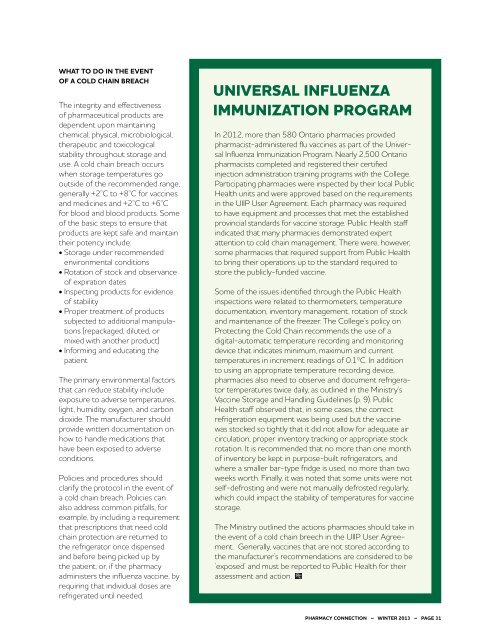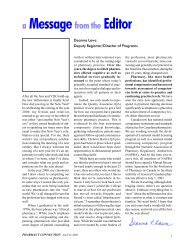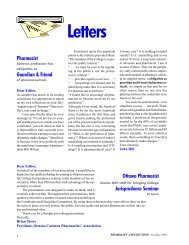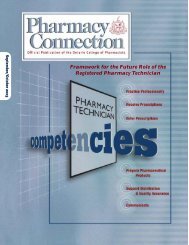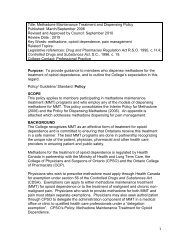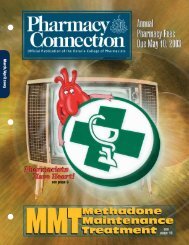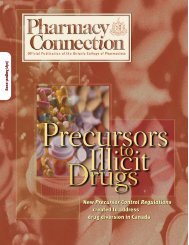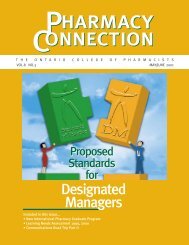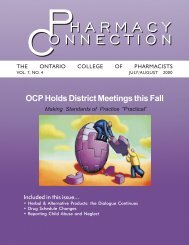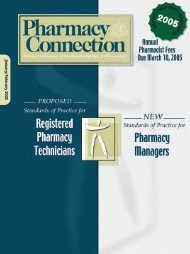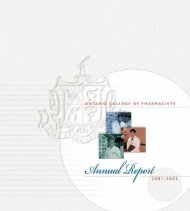Download - Ontario College of Pharmacists
Download - Ontario College of Pharmacists
Download - Ontario College of Pharmacists
You also want an ePaper? Increase the reach of your titles
YUMPU automatically turns print PDFs into web optimized ePapers that Google loves.
What to do in the Event<br />
<strong>of</strong> a Cold Chain Breach<br />
The integrity and effectiveness<br />
<strong>of</strong> pharmaceutical products are<br />
dependent upon maintaining<br />
chemical, physical, microbiological,<br />
therapeutic and toxicological<br />
stability throughout storage and<br />
use. A cold chain breach occurs<br />
when storage temperatures go<br />
outside <strong>of</strong> the recommended range,<br />
generally +2 o C to +8 o C for vaccines<br />
and medicines and +2 o C to +6 o C<br />
for blood and blood products. Some<br />
<strong>of</strong> the basic steps to ensure that<br />
products are kept safe and maintain<br />
their potency include:<br />
• Storage under recommended<br />
environmental conditions<br />
• Rotation <strong>of</strong> stock and observance<br />
<strong>of</strong> expiration dates<br />
• Inspecting products for evidence<br />
<strong>of</strong> stability<br />
• Proper treatment <strong>of</strong> products<br />
subjected to additional manipulations<br />
(repackaged, diluted, or<br />
mixed with another product)<br />
• Informing and educating the<br />
patient<br />
The primary environmental factors<br />
that can reduce stability include<br />
exposure to adverse temperatures,<br />
light, humidity, oxygen, and carbon<br />
dioxide. The manufacturer should<br />
provide written documentation on<br />
how to handle medications that<br />
have been exposed to adverse<br />
conditions.<br />
Policies and procedures should<br />
clarify the protocol in the event <strong>of</strong><br />
a cold chain breach. Policies can<br />
also address common pitfalls, for<br />
example, by including a requirement<br />
that prescriptions that need cold<br />
chain protection are returned to<br />
the refrigerator once dispensed<br />
and before being picked up by<br />
the patient; or, if the pharmacy<br />
administers the influenza vaccine, by<br />
requiring that individual doses are<br />
refrigerated until needed.<br />
UNIVERSAL INFLUENZA<br />
IMMUNIZATION PROGRAM<br />
In 2012, more than 580 <strong>Ontario</strong> pharmacies provided<br />
pharmacist-administered flu vaccines as part <strong>of</strong> the Universal<br />
Influenza Immunization Program. Nearly 2,500 <strong>Ontario</strong><br />
pharmacists completed and registered their certified<br />
injection administration training programs with the <strong>College</strong>.<br />
Participating pharmacies were inspected by their local Public<br />
Health units and were approved based on the requirements<br />
in the UIIP User Agreement. Each pharmacy was required<br />
to have equipment and processes that met the established<br />
provincial standards for vaccine storage. Public Health staff<br />
indicated that many pharmacies demonstrated expert<br />
attention to cold chain management. There were, however,<br />
some pharmacies that required support from Public Health<br />
to bring their operations up to the standard required to<br />
store the publicly-funded vaccine.<br />
Some <strong>of</strong> the issues identified through the Public Health<br />
inspections were related to thermometers, temperature<br />
documentation, inventory management, rotation <strong>of</strong> stock<br />
and maintenance <strong>of</strong> the freezer. The <strong>College</strong>’s policy on<br />
Protecting the Cold Chain recommends the use <strong>of</strong> a<br />
digital-automatic temperature recording and monitoring<br />
device that indicates minimum, maximum and current<br />
temperatures in increment readings <strong>of</strong> 0.1ºC. In addition<br />
to using an appropriate temperature recording device,<br />
pharmacies also need to observe and document refrigerator<br />
temperatures twice daily, as outlined in the Ministry’s<br />
Vaccine Storage and Handling Guidelines (p. 9). Public<br />
Health staff observed that, in some cases, the correct<br />
refrigeration equipment was being used but the vaccine<br />
was stocked so tightly that it did not allow for adequate air<br />
circulation, proper inventory tracking or appropriate stock<br />
rotation. It is recommended that no more than one month<br />
<strong>of</strong> inventory be kept in purpose-built refrigerators, and<br />
where a smaller bar-type fridge is used, no more than two<br />
weeks worth. Finally, it was noted that some units were not<br />
self-defrosting and were not manually defrosted regularly,<br />
which could impact the stability <strong>of</strong> temperatures for vaccine<br />
storage.<br />
The Ministry outlined the actions pharmacies should take in<br />
the event <strong>of</strong> a cold chain breech in the UIIP User Agreement.<br />
Generally, vaccines that are not stored according to<br />
the manufacturer’s recommendations are considered to be<br />
‘exposed’ and must be reported to Public Health for their<br />
assessment and action.<br />
PHARMACY CONNECTION ~ WINTER 2013 ~ PAGE 31


